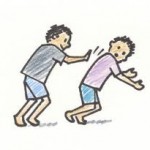The survey found that at least 50 percent had "bullied, teased or taunted someone at least once," and 47 percent had been physically abused, harassed or threatened in a way that seriously upset them.Some other findings Another interestingly aspect of the survey was that only 28 percent of the respondents (37 percent of boys and 19 percent of girls), believed that hitting or threatening someone is acceptable. Additionally, 21 percent students reported having mistreated someone because he or she belonged to a different group. Also, 23 percent admitted to being bias towards certain groups and 42 percent said they had used racial slurs. Consequences of bullying To simply assume that bullying is just a normal part of growing up is a misconception. Bullying is a serious problem that can dramatically affect the ability of students to progress academically and socially. Victims of bullying are typically anxious, insecure, depressed, sad and suffer from hopeless, low self-esteem, lack social skills, experience loneliness, sleeplessness and suicidal thoughts. Teens who are victimized are also inclined to the use of tobacco, alcohol, drugs and indulge in reckless sexual behavior. These risk behaviors are linked to negative health effects and poor mental health status. A comprehensive intervention plan that involves all students, parents, educators and lawmakers is needed to ensure that all students can learn in a safe and fear-free environment. ]]>
Uncategorized
50% high school students admit bullying in last year–survey
Joel Burns tells gay teens “it gets better”
In a courageous, intensely emotional talk at the city council in Fort Worth, Texas, councilman Joel Burns reaches out to the targets of teen bullying — kids who are gay, perceived as gay, or just different — with a vital message about their lives, and the harassment they face.
New data on bullying: 17% report regular abuse
 New data on bullying released today show that 17 percent of American students report being bullied two to three times a month or more within a school semester, with girls and boys having similar rates.
New data on bullying released today show that 17 percent of American students report being bullied two to three times a month or more within a school semester, with girls and boys having similar rates.
The information was gleaned from an anonymous survey of 524,054 U.S. students in grades 3 through 12, and it comes when bullying is in the news because of a series of suicides by young gays who had been bullied.
The survey was conducted by Dan Olweus (pronounced Ol-VEY-us), who is considered the founding father of research on bully/victim issues. It is being released by the Olweus Bullying Prevention Program.
The program for elementary, junior high and middle schools that he created is aimed at preventing and/or reducing bullying and is designed to improve peer relations and make schools safer places. (You can find reports analyzing different bullying programs here.)
Researchers say that the approach, which involves every adult and student in the class and helps teach students how to safely not be bystanders when bullying occurs, has been shown to have the strongest and most long-lasting improvements.
The co-author of the analysis is Susan P. Limber. Here is some of the information released today:
Being bullied
Bullying others
10 percent of students indicated they had bullied others with some frequency (two to three times per month or more within the semester).
How long has the bullying lasted?
16 percent of girls boys reported having been bullied for about a year. 23 percent of girls and 30 percent of boys said they had been bullied for several years.
Bystander behavior
I have never noticed that students my age have been bullied.
Girls: 24 percent. Boys: 30 percent.I take part in the bullying.
Girls: 1 percent. Boys: 3 percent.I don’t do anything but think it is OK.
Girls: 1 percent. Boys: 2 percent.I just watch what goes on.
Girls: 9 percent. Boys: 14 percent.I don’t do anything, but I think I ought to help the bullied students.
Girls: 30 percent. Boys: 22 percent.I try to help the bullied student.
Girls: 35 percent. Boys: 29 percent.
More than 40 states have some sort of law that makes bullying illegal, yet, as the statistics show, the harassment of young kids by their classmates remains common.
Clearly laws alone can’t get the job done. Parents have to be involved, and so do schools.
A school-wide assembly to discuss bullying won’t work. Schools that are serious about reducing bullying implement programs that involve every adult in the school, from the principal to the janitors, and spend time once a week engaging students in discussion and activities to understand the problem and learn how to deal with it.
This is not a topic that we hear our education leaders talk about very much, except when someone dies.
If we want kids to feel safe enough in schools to do well academically, bullying is a topic that should no longer be ignored.
By Valerie Strauss | October 20, 2010; 3:00 PM ET
Five Ways People Are Working to Put School Bullying in Check
By Kyle Bella
Since July, an alarming number of LGBT teens and college students have committed suicide. From Tyler Clementi, 18, a Rutgers University freshman, to the most recent to make headlines, 19-year-old former Howard University student Aiyisha Hassan. The suicides, in particular Clementi’s, have brought attention to how endemic bulling is in adolescent culture, from physical assault to Internet harassment. It doesn’t end with overt hostility, however. A 2009 survey by GLSEN, which advocates for safe space in schools for LGBT students, found that, “88.9% of students heard ‘gay’ used in a negative way (e.g., ‘that’s so gay’) frequently or often at school.” Even more troubling is the fact that “40.1% of students were physically harassed” and “18.8% were physically assaulted.”
But the GLSEN survey also discovered that bullying is not confined to LGBT students. Nearly three quarters of students, 72.1 percent, heard sexist remarks “frequently or often” and 40.6 percent heard racist remarks “frequently or often.”
The recent torrent of bad news about LGBT youth harassment in particular has prompted many to ask, what can we do to help? Broader, more inclusive strategies to combat bullying need to be enacted to ensure that all students, regardless of gender identity, sexual orientation, race or disability status, are made to feel safe and welcome in their schools.
The Make It Better Project provides an excellent collection of resources to directly empower youth to act to stop bullying of all types, including a how-to guide on interrupting bullying when you see it happening. It also offers a resource list for parents on how they can support teens and prevent bullying. As one LGBT teen says in one of the project’s video testimonials, “I tried and succeeded at making it better for myself. I didn’t just wait and hope that it would get better. I found a whole world of people and places and experiences that I never thought that I would have.” That’s what activism can do. So we asked other anti-bullying advocates to chime in with their own strategies for ensuring a better school climate for all students. Here are five solutions we found at work in schools across the country. There are many, many more. If you’ve got any to highlight, chime into the comments below.
 Create Alliances
Create Alliances
Gay/Straight Alliances are student-run organizations that began in 1998 when a straight student reached out to GLSEN-founder Kevin Jennings. Today there are more than 4,000 clubs in all 50 states, Puerto Rico and on U.S. military bases. They provide LGBT students a non-judgmental space and support straight allies. State-based coalitions such as the GSA Network, work to spread the clubs in both rural and urban public schools where they are harder to establish. This past year, the coalition worked with a small group of middle school students at Tomas Rivera Middle School in rural Perris, Calif. Their group is now thriving and is working with the network to “train and empower students in isolated places.” (Photo by Caitlin Childs)
 Acceptance as Core Curriculum
Acceptance as Core Curriculum
The Alliance School opened in Milwaukee in 2005 as a small public charter school in grades 6-12. The school is built “with the goal of providing a safe and accepting environment for all students.” It emphasizes, as leader-teacher Tina Owen says, “building compassion and teaching acceptance for all people” through “preventative practice so that we are addressing unkind deeds and words before they become bullying.” Students participate directly in creating school policies, through student government organizations. Harassment forms are always available. And the school works toward fulfilling the principle that “no one ever says ‘we can’t do anything about that.’ ” (Photo by Ryan Stanton)
 Make It Comprehensive
Make It Comprehensive
The Olweus Bullying Prevention Program also starts with a comprehensive school reform. It has since been used in both urban and rural public schools, across the country and internationally. As Marlene Synder, research associate at the affiliated Clemson University, says, “It is a system-change, requiring the long-term commitment of all members of the school system.” It emphasizes a student-driven approach, building on a student survey that allows a school to understand its specific bullying concerns. The program emphasizes staff training because so much of the focus is on anti-bullying curriculum, including role-playing exercises and active parental involvement. (Photo by Eddie~S)

Teaching Through Film
GroundSpark is an organization that was founded in 1978 as Women’s Educational Media. The new name reflects a broader commitment “of creating visionary films and dynamic educational campaigns that move individuals and communities to take action for a more just world.” One of these campaigns is the Respect for All Project, which offers a series of award-winning films for students ranging from grades K-12, as well as teachers, parents and youth-service providers. All films include a curriculum guide for understanding differences—including ethnicity, gender and sexual orientation—into the day-to-day classroom setting. GroundSpark also runs “Professional Development Workshops” that have educated over 10,000 individuals since 2003, addressing how to use films as educational tools and how to adapt these to a wide variety of settings, from urban to rural and public to private.
 Start Early—and Help Kids to Stand Up For Themselves
Start Early—and Help Kids to Stand Up For Themselves
True Colors is a Connecticut non-profit that is committed to “full equality for all LGBT youth, adults and families” and “to the work of social justice as an anti-racist institution.” The organization provides a number of important resources for LGBT youth across the state that include working directly with Gay/Straight Alliances to facilitate “summits” to build connections within communities. Executive Director Robin McHaelen says the organization is focused particularly on developing middle school Gay/Straight Alliances, given the fact that the “average age of coming out today is 11 to 13.” True Colors also implemented the “Youth Activist Institute,” a six-week training program that enables youth to “advocate for themselves and others” in response to all forms of harassment. Listen to the young people talk for themselves on CNN in the video below.
Combating Gay Teen Suicide: What Parents Can Do
Dr. Harold Koplewicz
 Over the past few weeks it has been impossible to miss the flood of news stories about gay teens ending their own lives after enduring anti-gay bullying. Eighteen-year-old Tyler Clementi, 15-year-old Billy Lucas, and 13-year-olds Asher Brown and Seth Walsh were living in different corners of America — New Jersey, Indiana, Texas, and California — but each of them was subjected to the same kind of intolerance and cruelty, which included callous disregard for their online privacy.
Over the past few weeks it has been impossible to miss the flood of news stories about gay teens ending their own lives after enduring anti-gay bullying. Eighteen-year-old Tyler Clementi, 15-year-old Billy Lucas, and 13-year-olds Asher Brown and Seth Walsh were living in different corners of America — New Jersey, Indiana, Texas, and California — but each of them was subjected to the same kind of intolerance and cruelty, which included callous disregard for their online privacy.
To put this tragedy in context, suicide is the third leading cause of death among adolescents aged 15 to 24, and gay teens are six times more likely than straight teens to attempt suicide. It’s important to understand, though, that the statistics concerning gay teens are relevant to all teens. There are many reasons for this, but chief among them is that during adolescence, the mantra is, “I want to be the same, I want to be the same, I want to be the same.” Teens want to be like everyone else, and when they see a gay student getting bullied for some perceived difference, they worry that their own differences — and we all have them — will be targeted by bullies next.
I know that many parents find it difficult to discuss sexuality with their teens, but discussion is crucial if we want our teens to develop good self-esteem, embrace their own differences, and accept what is different in others.
Here’s some information for parents to consider:
Teens who are “different” are at higher risk for getting bullied.
All teens want to be “normal” and fit in with their peers, but when they exhibit differences — in their sexual orientation, for example — they can face cruel and unusual harassment and rejection. According to a survey by the Gay, Lesbian, and Straight Education Network, approximately 90 percent of gay, lesbian, transgender or bisexual middle and high school students were physically or verbally harassed in 2009. As parents, no matter what we believe (with respect to sexuality, religion, politics, etc.), we are responsible for our kids’ behavior and need to teach them to be intolerant of intolerance.
A teen who believes his sexual feelings are unacceptable to peers may be experiencing emotions that are warning signs of suicide.
Parents, teachers, and all caring adults need to be alert and sensitive to how self-esteem contributes to a teen’s feelings of sadness, worthlessness, hopelessness, anxiety, irritability, rejection, and anger — all symptoms of depression that affect the majority of teens who attempt or complete suicide. Some parents fall under the impression that because they are tolerant of different sexual orientations, their children aren’t affected by the barrage of messages about “how wrong it is to be gay.” Unfortunately, anti-gay rhetoric has extraordinary, insidious muscle in the cultural landscape, and gay teens are particularly vulnerable to the discrimination and bullying that chip away at self-esteem and contribute to depression. Parents of gay teens are sometimes just “the last to know” a problem is brewing.
An overwhelming majority of suicidal teens report feeling misunderstood by their parents.
Therefore, it’s crucial for parents to start a conversation with their children, before they go through puberty, to discuss sexual feelings and tolerance of different sexual orientations. If your child is secretly feeling guilty or somehow bad due to the sexual thoughts he or she is having, you need to know this so that you can give reassurance that there’s nothing wrong or bad about different sexual thoughts or sexuality in general. Teens who feel uncomfortable with their sexuality often suffer from low self-esteem, so it’s essential that we counter their feelings of distress with a very positive message of acceptance and love. We have a responsibility and role in building our teens’ self-esteem and self-confidence. They need to understand that while we sometimes disagree with them — or simply have different feelings — we respect their beliefs and differences. We love them no matter what.
As part of the effort to prevent suicide and suicidal behaviors, parents need to know about their teens’ lives on the Internet.
I’m reminded of a scene in the new Facebook movie, “The Social Network,” in which Napster co-founder Sean Parker (played by Justin Timberlake) says, “We lived on farms. We lived in cities. And now we live on the Internet.” That we now “live” on the Internet means that, as parents and educators, we must be whistleblowers on Facebook, Twitter, and any other social media platform on which our kids interact — to tackle intolerance and bullying effectively. Online bullying often involves the complete failure, on the part of a bully, to comprehend how words and actions in cyberspace can devastate a victim. Erica makes this point in “The Social Network” when she tells Mark Zuckerberg that saying something cruel to a person’s face is like using a pencil (since spoken words can fade from memory), but saying something online, where words are recorded for an unknown number of people to see, is like using a pen. We have to talk to our kids about the power and consequences of our online behavior. And then we need to teach them how to use social media as a tool for promoting tolerance, compassion, and social justice.
Parent-teen communication is our best defense against intolerance, bullying, and teen suicide.
Believe it or not, teens want to spend time with their parents. We sometimes forget this as we watch them try to assert their independence, but research studies repeatedly show that teens want to spend quality time with us — and when they do, they’re less likely to experiment with drugs, have sex at a young age, and engage in other risky behaviors. We have the opportunity to build our kids’ confidence and self-esteem, nurture empathy, and model an acceptance and appreciation of others. However (and this is key), teens only want to spend time with their parents — and talk openly about what they’re really experiencing — when they believe their parents aren’t judgmental. Again, tolerance, respect, appreciation, love.
I’m encouraged by the fact that so many celebrities — from Cyndi Lauper and Ellen DeGeneres to Matthew Morrison, Jane Lynch, and the entire cast of “Glee” — are raising public awareness of anti-gay bullying and its links to teen suicide.
I hope you will join me in promoting tolerance to protect young lives. Please start right now by having a conversation with your child.
Harold S. Koplewicz, M.D. is a leading child and adolescent psychiatrist and the president of the Child Mind Institute.
Cyber bullying: What should parents do?
By ELIZABETH ESTHER
 A webcam is not only a powerful communication tool, it’s also a potentially deadly weapon. When wielded as an instrument of personal destruction, a webcam is the nuclear weapon of modern bully warfare. And when used in conjunction with social media, the soul-crushing humiliation of cyber-bullying can be fatal.
A webcam is not only a powerful communication tool, it’s also a potentially deadly weapon. When wielded as an instrument of personal destruction, a webcam is the nuclear weapon of modern bully warfare. And when used in conjunction with social media, the soul-crushing humiliation of cyber-bullying can be fatal.
Tyler Clementi was among four young men who committed suicide last month after being bullied. And in Tyler’s case, the bullying was particularly cruel — his private, romantic tryst streamed live over the Internet. What I want to know is: how many more children must die before we, as parents and as a society, take seriously the dangers of bullying?
In the wake of Tyler’s death, efforts to curb cyber-bullying seem like meager, farcical attempts at containing the roaring beast that is online harrassment. The reality is that a cyber-bully has near unlimited power: the ability to broadcast cruelty to everyone with an Internet connection. That’s an astonishing scope of damage. And because the potential for damage is so vast, something equally powerful must be done to stop this from happening again. But what can be done?
I don’t know that we’ll never be able to eliminate all bullies. Even if the laws catch up to the rapidly advancing technology (and thankfully, at least 45 states have signed anti-bullying laws), bullies will thrive wherever there are apathetic bystanders. Evil happens when good people remain silent. And I do believe the majority of kids are good-hearted. We need to find a way to encourage them to stand up when they see someone being bullied or harassed. Is that too much to ask?
If there were less kids laughing at the bully’s jokes, egging the bully on and generally not speaking up for what’s right, would this be less of a problem? I think so. Sometimes all it takes is for one or two bystanders to speak up and say: “No. Stop. That’s not funny.” Silence is complicity and since most bullies are cowards anyway, they’re betting on everyone else to act cowardly, too.
Certainly there is a social cost to speaking up and it makes me wonder if that’s a price many young people aren’t willing to pay. Are they afraid that speaking up will make them a target? Is speaking up on behalf of the defenseless considered uncool? Perhaps this is why parents should be willing to support and intervene in bullying situations. Our kids need to know they’re not alone. If we, as parents, aren’t ready to exercise courage, how can we expect our children to act courageously?
I realize it’s rather unpopular for parents to intervene on their child’s behalf. I’ve heard the research about educating children to solve their own problems. But I think there comes a point when parents should step in. When a bully has targeted a particular child, it’s my job to step in. Otherwise, I’m subjecting my child to a Lord of the Flies environment. The only thing bullies respect is an authority figure bigger and stronger than they are. I don’t like confrontation, but when my child’s safety is in danger, it’s my responsibility to overcome my discomfort and defend my child — and other vulnerable children, too.
However, I can’t do this job alone. I do hope the law will continue to catch up to technology. I say it’s high-time the law considered cyber-bullying a serious crime. But I also firmly believe it’s each parent’s responsibility to be proactive in their children’s lives and social circles.
As a parent, I want to be brave enough to speak up in defense of vulnerable children in my kids’ schools. I urge you to do the same.
NJ senator calls for anti-bully law after suicide
By BRUCE SHIPKOWSKI and BILL NEWILL (AP) –
 NEW BRUNSWICK, N.J. — Colleges should adopt a code of conduct that prohibits bullying and harassment in the wake of the suicide of a Rutgers University student whose gay sexual encounter in his dorm room was streamed online, U.S. Sen. Frank Lautenberg said at a town meeting on campus.
NEW BRUNSWICK, N.J. — Colleges should adopt a code of conduct that prohibits bullying and harassment in the wake of the suicide of a Rutgers University student whose gay sexual encounter in his dorm room was streamed online, U.S. Sen. Frank Lautenberg said at a town meeting on campus.
Lautenberg, D-N.J., told the crowd gathered Wednesday night in memory of 18-year-old freshman Tyler Clementi that he would introduce such legislation. Clementi jumped off the George Washington Bridge into the Hudson River on Sept. 22 after the intimate images of him with another man were broadcast. His body was identified days later.
Clementi’s roommate, Dharun Ravi, and another Rutgers freshman, Molly Wei, both 18, have been charged with invasion of privacy, and authorities are weighing whether bias crime charges should be added.
Prosecutors have subpoenaed Rutgers University for e-mails concerning how the school handled complaints from Clementi that his roommate used a webcam to spy on him, according to The Star-Ledger of Newark.
The newspaper reported that prosecutors asked for the subpoenas after investigators felt the state university was not fully cooperating with the invasion of privacy case.
The Star-Ledger cited two officials who were briefed on the probe, but did not name the officials because they were not authorized to speak about the ongoing inquiry.
The death of Clementi, a promising violinist, has prompted a national discussion on the plight of young gay people and bullying, along with technology’s role in it. Clementi typed his intention on the Internet, leaving a note on his Facebook page reading, “Jumping off the gw bridge sorry.”
A new survey has found that while technology has become so entwined with college students’ often frantic lives, being perpetually connected comes at a cost.
The Associated Press-mtvU Poll released Thursday found that while 57 percent of students said life without computers and cell phones would make them more stressed, a significant number — 25 percent — said it would be a relief.
The AP-mtvU Poll of more than 2,000 college students, conducted before Clementi’s death became public, found that 9 in 10 had been on a social networking site like Facebook in the past week. One in five say they’ve posted public messages on such sites seeking emotional support, while more than two-thirds say they’ve read public posts by friends pleading for such assistance.
Clementi’s death was one of a string of suicides last month involving teens believed to have been victims of anti-gay bullying. Just days after Clementi’s body was recovered, more than 500 people attended a memorial service for a 13-year-old central California boy, Seth Walsh, who hanged himself after enduring taunts from classmates about being gay.
The Rutgers event, organized by the university and the gay rights activist group Garden State Equality, drew about 300 students and others, including U.S. Sen. Robert Menendez, D-N.J., U.S. Rep. Frank Pallone, D-N.J., and actress/comedienne Judy Gold, a Rutgers grad and gay activist who won two Daytime Emmy Awards as a writer and producer for “The Rosie O’Donnell Show.”
“No one could have heard about this degradation he suffered without feeling pain themselves,” Lautenberg said. “This is a major problem, and we’re going to fix it.”
Gold expressed outrage at the pain inflicted on Clementi.
“What happened to him was not just an invasion of privacy,” she said. “This was just sick.”
Lautenberg said his bill would require colleges and universities that receive federal student aid to create policies prohibiting harassment of any student. Such policies are not currently required by federal law, he said. The bill also would provide funding for schools to establish programs to deter harassment of students.
Middlesex County prosecutor Bruce Kaplan said earlier this week that he wouldn’t rush the investigation into Clementi’s death.
Ravi’s lawyer, Steven D. Altman, issued a statement Wednesday saying he was “heartened to hear” that investigators are taking their time “to learn all the facts before rushing to judgment” about whether to file bias charges against his client. Altman said he hoped the public would do the same.
“I am confident that nothing will be learned to justify, warrant or support the filing of any bias criminal complaint,” Altman said.
Lawyers for Wei released a statement Tuesday saying she was innocent and extending sympathy to the Clementi family.
“This is a tragic situation,” the statement said. “But this tragedy has also unfairly led to rampant speculation and misinformation, which threaten to overwhelm the actual facts of the matter. Those true facts will reveal that Molly is innocent.”
Ravi, of Plainsboro, and Wei, of Princeton, each could face up to five years in prison if convicted on the invasion of privacy charge.
Newill reported from Trenton, N.J. Associated Press Writers Alan Fram and Trevor Tompson in Washington contributed to this report.
Father fights bullying to honor son
Asher Brown Suicide: Parents Speak Out Against Bullying
By AAyles on September 30th, 2010
 Asher Brown was a 13-year-old boy who, like most young boys, enjoyed reading, playing outside and hanging out with his dad. His mom said he seemed sad and withdrawn in the months leading up to his suicide this week and most of his sadness was contributed to bullying at school.
Asher Brown was a 13-year-old boy who, like most young boys, enjoyed reading, playing outside and hanging out with his dad. His mom said he seemed sad and withdrawn in the months leading up to his suicide this week and most of his sadness was contributed to bullying at school.
Asher’s parents say that their son was bullied at school for countless reasons. In addition to being gay, their son was bullied for being small, not wearing name-brand clothing, not using iPods and choosing to read instead of listening to music. “He wasn’t interested in those things,” said his parents in an interview with CNN today. “We could have bought it for him, we asked him if he wanted them and he said no, there are more important things.”
Asher shot himself in the head after almost 2 years of bullying. He told his parenst he was gay the morning of his death.
The young boy’s parents are speaking out in hopes of raising awareness to issues like bullying in schools. They insist they reported the issue to Asher’s school but the school denies any reports of bullying with Asher, or any other student in the school.
Suicide as a result of bullying in teens and young children is becoming more and more of a problem. In the last 3 weeks, 3 young boys (Asher, Tyler Clementi and Seth Walsh) have committed suicide as a result of bullying.
If you think your child may be a victim of bullying, talk to them and take appropriate actions.
“Please if you have children that you think may be bullied, if they seem sad or withdrawn and you ask questions and they say ‘I’m fine’ push past that. Push past the ‘I’m fine,’” says Asher’s mom in the exclusive interview. “It’s extremely important. These kids are worried about retribution for speaking up. Not only speaking up for themselves but for their friends that are getting picked on.”
3 boys in 3 weeks. When will this end?
Playgrounds need trained staff to curb bullying
by Kim Schlender
As the kids go back to school and I hear the school bells ring, I think back to nearly 10 years ago, when I applied to be the playground lady at a nearby elementary school.
After a few days of being on the playground with 200-plus students, two monitors and one volunteer parent, I asked the principal what the student-to-supervisor ratio was. He looked at me strangely and said there wasn’t one. He said there were no state-mandated standards. I also learned that there was no training offered to the playground staff, other than CPR.
How many times have we heard that bullying starts on the playground? And here I found myself on that playground with no training, no disciplinary options and no support. Over the three-plus years I suggested several times that we bring in some trainers, meet with district social workers or at least put a behavior plan in place that would give us some authority. The message I got was that it wasn’t a priority.
Clearly I could not watch so many children and see everything. I made sure that I was visible to the kids, and I watched for the kids who seemed to be alone and those who seemed troubled day after day.
I noticed many of those kids would stay near me, which created a safety net of sorts. Many were also eager to talk and just have someone know who they were.
Then, of course, there were the troublemakers. I hoped that if I kept an eye on them and they knew it, they would make better choices. Often it actually worked. I was even able to catch them doing something good from time to time.
What frustrated me the most was that some kids seemed to think they could do and say whatever they wanted to. The attitude seemed to be that they could tease, taunt, be mean and tell other kids what to do. Often these were the popular kids, who had a group of followers. It seemed they were kings and queens of the playground.
Of course they were told to be nice — but remember, we had no guidelines on how to discipline or work with these kids. There were no real consequences and the kids knew it.
What kept me coming back was that, overall, the kids were kind and respectful and really wanted to do the right thing. And the volunteer parents really made a difference by being present.
Perhaps we don’t need to legislate ratios and standards, but we should recognize that playgrounds are understaffed and that they need trained, caring people to watch over our children. The playground should not be a scary or unsafe place. We can help kids make good choices about how they treat others by putting some time and resources into ensuring that the playground is a great place for kids and the adults who care for them.
I would encourage those who can to volunteer on a playground or in a lunchroom. Better yet, work with the PTO or site counsel at your school to get some training for the playground staff. And better still, model and teach your kids to be kind and respectful to others.








